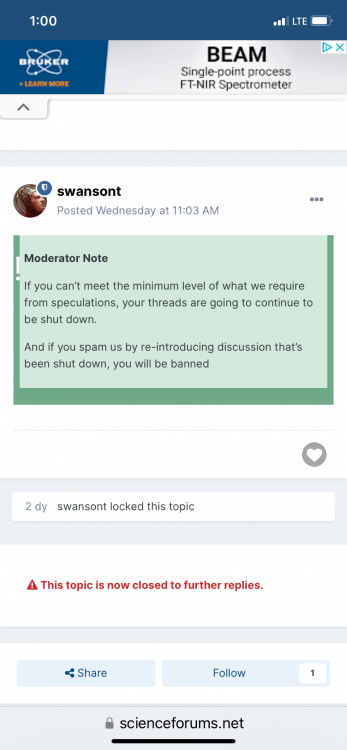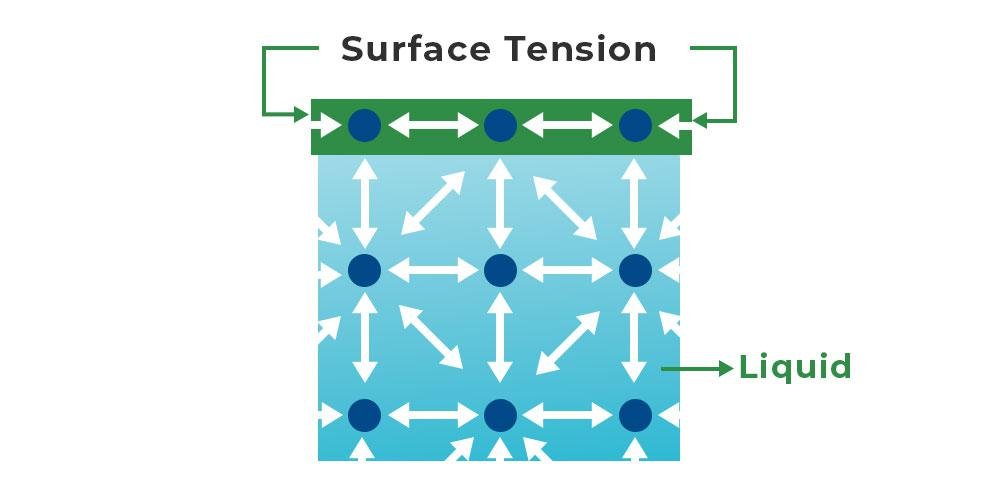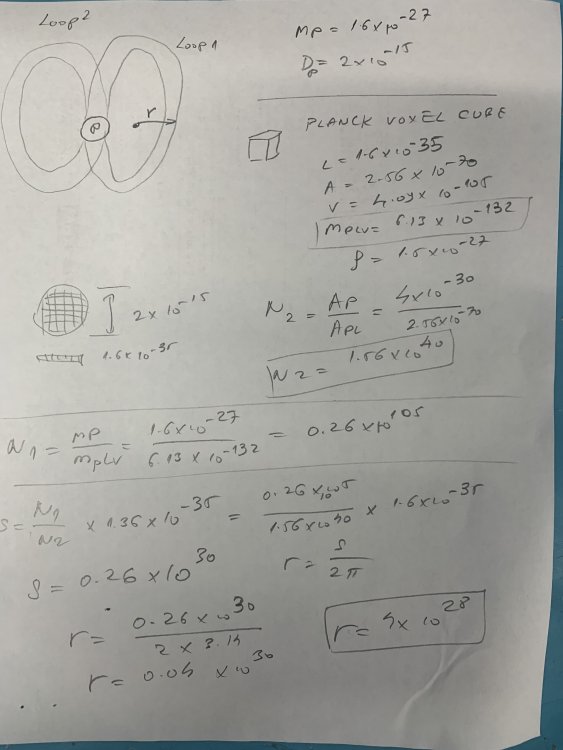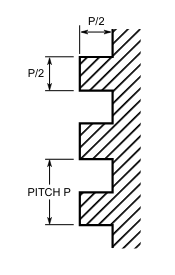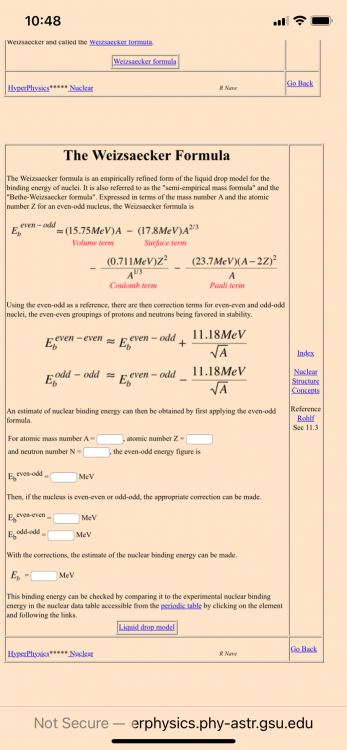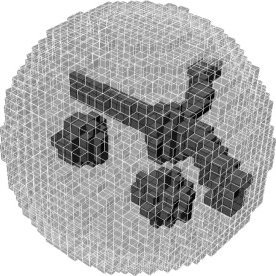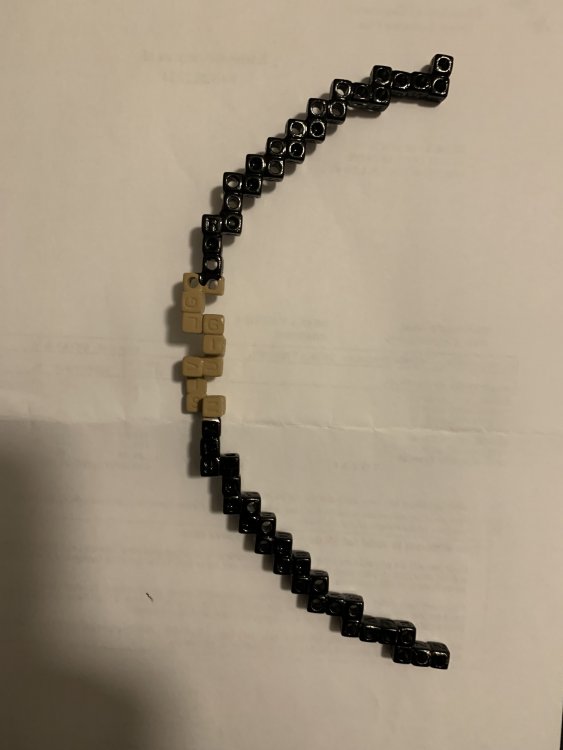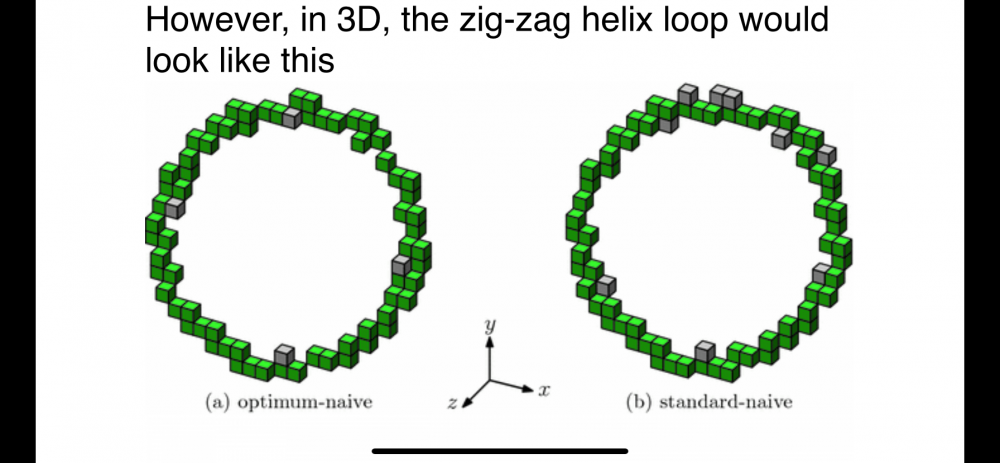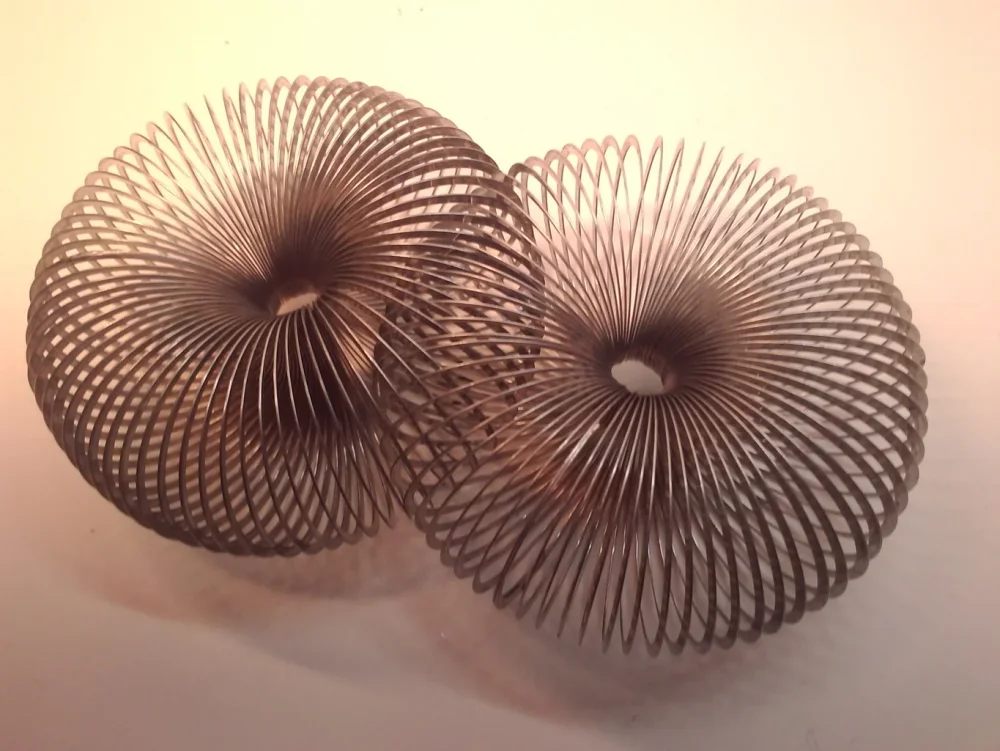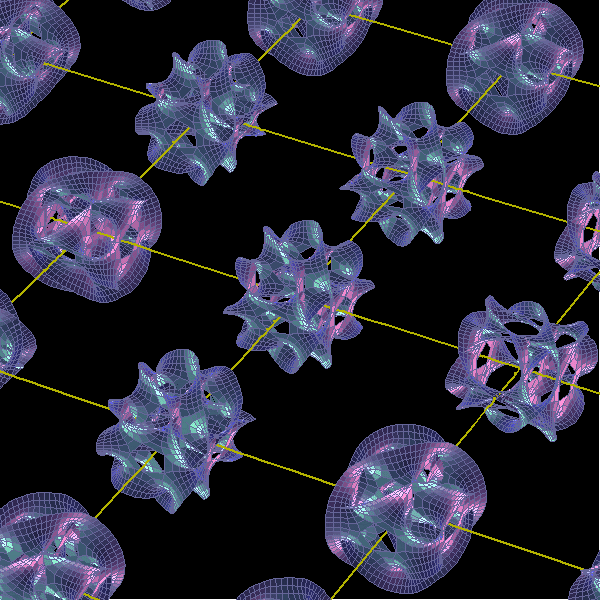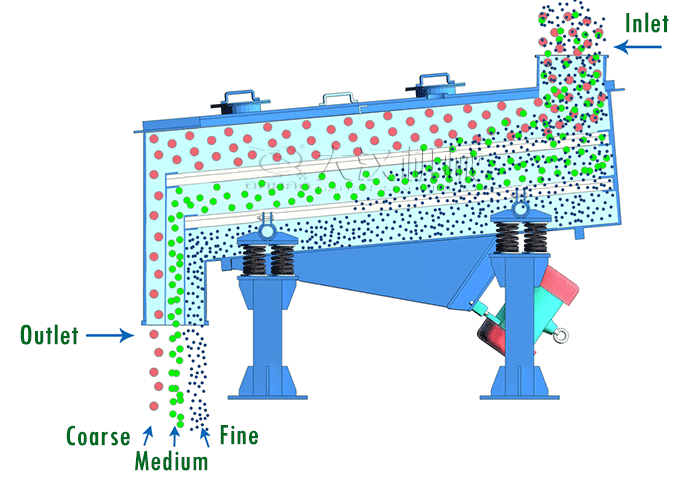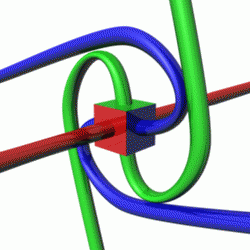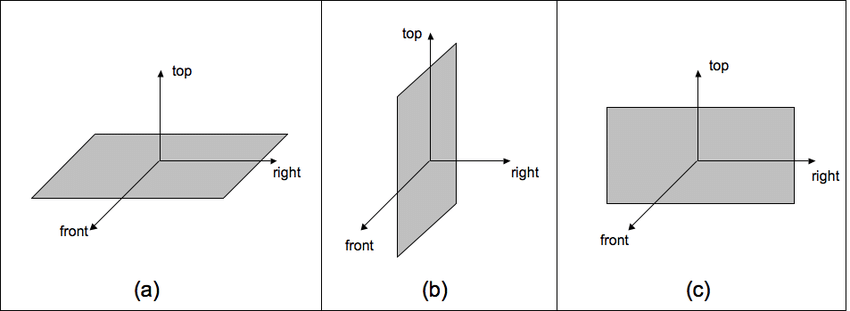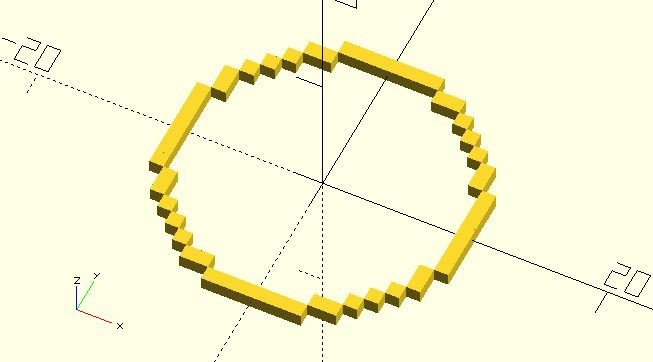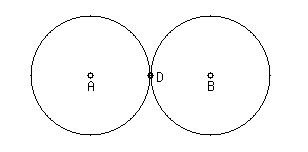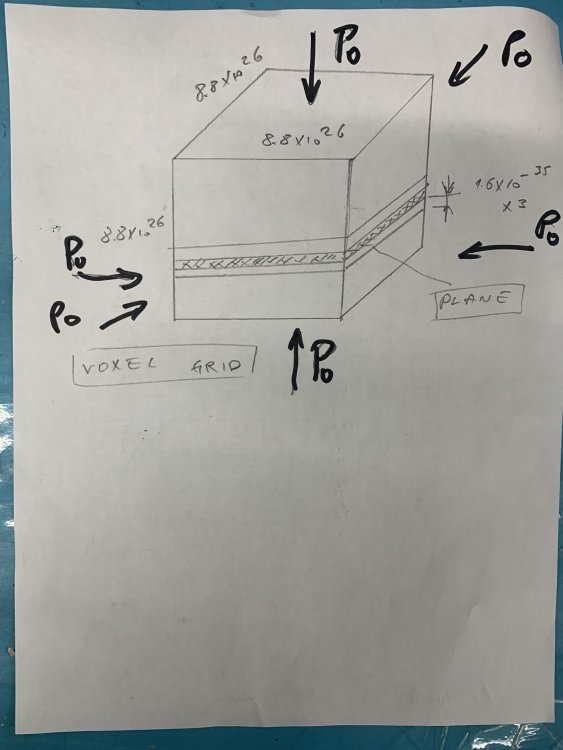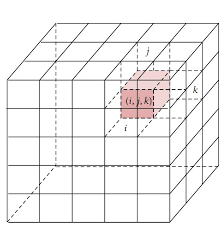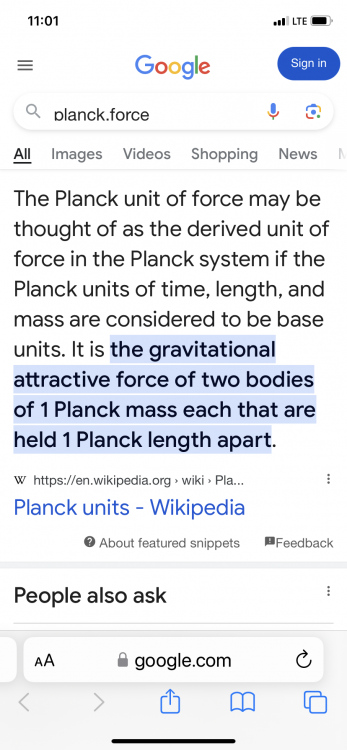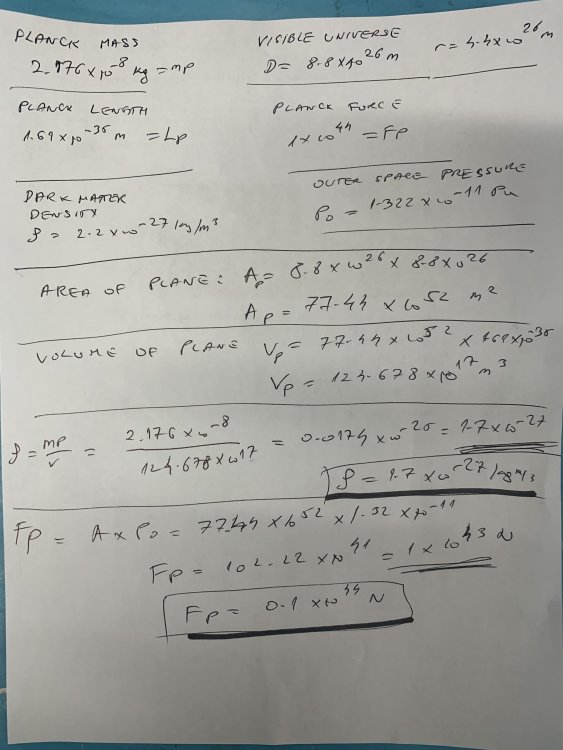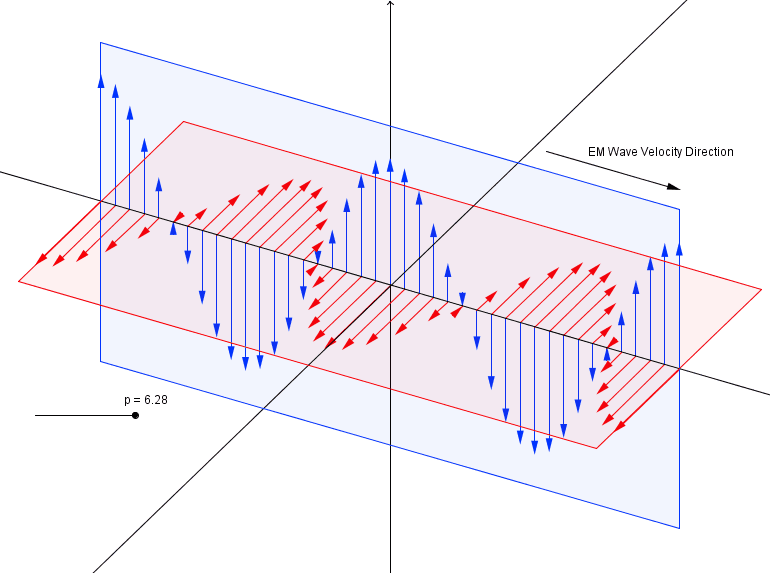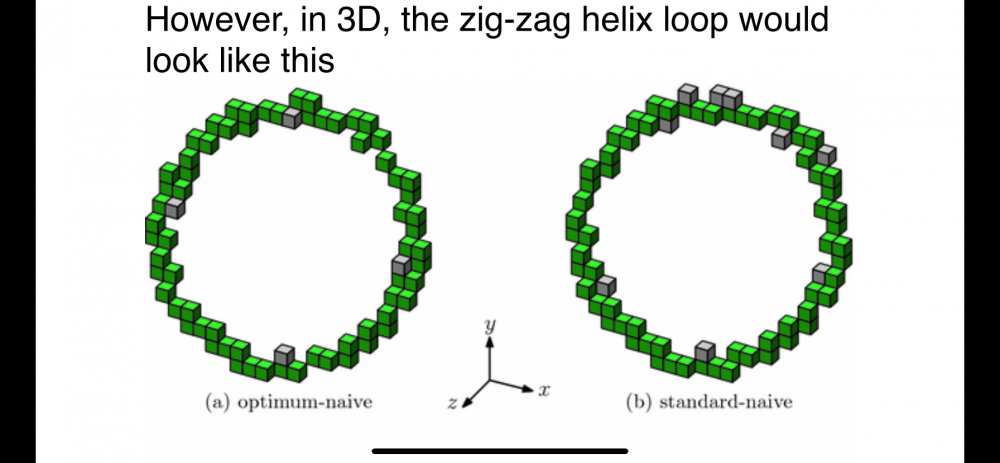

jv1
Senior Members-
Posts
57 -
Joined
-
Last visited
jv1's Achievements

Meson (3/13)
-28
Reputation
-
Exchemist That is a good one. Joking a side ,i would strongly recommend to all of physicists to take a course or two in fluid mechanics. i would like to ask moderator to lock this thread . tx
-
Hi again I would like to thanks to science forums for giving me opportunity to share a very different and more simply view on physics I promise I will not come to speculations thread ever again. I have learned a lot from science forums and I will try to learn more. I would like to finish this speculation threads of mine with two words super symmetry. cheers
-
I would like to add couple of more things. The average sized galaxies (small bubbles) inside the visible universe (big bubble) are acting on each other with gravitational force. The surface tension T=F/L F=Fg=0.97x10e25 L=27.63x10e26(half of circumference of big bubble) T=0.0035 Pi-Po=4T/r Po=(1.3x10e-11)-(3x10e-29) The outside pressure Po acting on bubble is very close Pi pressure acting inside of the big bubble. If the proton is made of two zig zag helix loop and loops are made of Plancks size cubes here is very rough picture : To calculate the size of loops for proton the mass and diameter of proton is starting point. The Planck cube mass and diameter are used too. N1 is number of Plancks cube masses inside the proton mass. N2 is number of Planck cubes inside the area of cross section of proton diameter . S=N1/N2 S is length of loop 1 and 2 . S is circumference of loop. The r=4 x10e28m This is very close to 4.4x10e26 m diameter of big bubble. The cross section are of proton Shown as a circle (N2)of Planck cubes (single layer) is area where half of cubes are moving CW with loops 1 and CCW with loop2 .This is main spin . At the same time cubes have zig zag motion they go perpendicular to the main spin and create intrinsic spin. The number of cubes in “vertical “part of zig zag motion will moving at the same time will create pitch- the spin number .Two loops are going to be “pushing “against each other and creating spinning motion - the main spin around proton. The cubes moving perpendicular will create Pauli/ pairing - intrinsic spin. Just one more thing- any change we afflict to proton ,if we alter number of cubes flowing through the proton ,will automatically change number of cubes or flow of cubes on both loops .On both loops at the same time at very big distance - there is nothing “spooky “ about that .
-
Hi swansont I am not reinventing the wheel. Everything in standard mode is accurate to the letter . I just want to point out few overlooks and point out few directions where the standard mode can be better understood. If you connect this and my previous threads this “model “points out few things: 1)the fractal nature of universe 2)the total binding energy between all protons in visible universe is equal to gravitational energy between all galaxies in the visible universe 3)the Planck force - pure theoretical term is equal to force created by pressure Po acting on outside surface of visible universe 4) the average density of visible universe is equal to pure theoreticaly calculated density of dark matter. 5)it connect liquid drop and shell model 6) it explains what happens on Planck scale ,sun atomic scale,atomic scale ,molecule scale All the way to interaction between galaxies. 7)it explains in 3D the spin of particles 8)connection between electromagnetic properties of particles with fluid nature of particles 9)change of pressure Po acting on outside of visible universe create vibration which produces motion of particles inside . 10) fundamental forces have all the same nature - electromagnetic nature . The gravitational force is crated the same way as the other forces- by change in pressure Po acting in the outside of “big bubble”. 11) the smallest particle in universe is Planck sized cube
-
Liquid drop model revisited The liquid drop model explains forces in atomic nucleus as they were created by tiny liquid drops. It is based partially on theory and partially on empirical measurements. In this revisited model The visible universe is seen as bubble/nucleus of liquid with diameter of 8.8x10e26m.In the further text big bubble. The galaxies inside the bubble are seen as a nucleons.In further text small bubbles. For simplicity of calculation we are going to use average size of galaxies. The number of galaxies inside the visible universe is Ng=2x10e12. The mass of galaxies is found to be 10e7 to 10e12 solar mases. Mass of average size of galaxy is calculated to be ma=2 x10e39kg. The sizes of galaxies are in the range of few to 100 kiloparsecs. The size of average galaxy is Da=4.89x10e20 m.We do not know the average "height" of galaxy. The average distance between two galaxies is 1x10e6 light years da=9x10e21m In visible universe there is about 10E80 protons . There is about 7 protons for one neutron in universe. Z=10x 10e79 N=10e80/7=1.4X10e79 A=11.4x10e79 The average galaxy has Za=10x10e79/2x10e12 Za=5x10e67 Na=5x10e67 /7 Na=0.71x10e67 The Aa=5.71x10e67 From formula R=Ro/A1/3 Ro=R/A1/3 Ro=4.4x10e26/(2x10e12)e1/3 Ro=5.5x10e30m Ro= height of galaxy. We already know one size of average galaxy is Da= 4.89x10e20 Foer approximation the volume of average galaxy is Va=Rox Pi x( Da)e2 Va=(4.89x10e20)e2 x3.14x 5.5x10e30 Va=412x10e70 The density od average galaxy is D=ma/Va D=2x10e39/412x10e70 D=0.0048x10e-31 D=48x10e-27kg/m3 The average density of big bubble(visible universe) is very close to average density of dark matter inside the visible uni. The force acting on surface area of big bubble is F=PoxAbb F=246.10e52 x 1.3x10e-13 F=0.316x10e44N The force acting on the outside surface area of big bubble is very similar to Planck's force. Binding energy between two closest average galaxies(small bubbles)can be calculated from Formula for gravitational energy. U=Gx(ma)e2/da U=6.6x10e-11 x (2x10e39)e2 /9x10e21 U=8.8x10e46J There is 1x10e12 pairs of nucleons (small bubbles) creating this energy) Total binding energy of big bubble is Et=8.8x10e46 x 10e12 Et=8.8x10e58J*********** The binding energy calculated by Weizsäcker formula : E=15.75 x A - 17.8 x A e1/3 (Columb and Pauli term are negligible) E= 15.75 x5.71 x 10 e67 - 17.8x(5.71x 10e67)e2/3 E=89.9x10e67-14.7x10e44 E= 89.9x10e67 mev One ev=1.6x10e-13J E=89.9x10e67x 1.6x10e-7 E=142.4x10e60********** The total binding gravitational energie Produced by little bubbles - seen as nuclons is very similar (close) to total energy produces by total number of protons inside the big bubble (weizsaecker formula ). In fractal cosmology is stated that distribution of matter in the universe or structure of universe itself is fractal across wide range of scales. On sub atomic level all terms(volume,surface,columb and pauli) play important contribution to binding energy. On Plancks scale the terms (volume,surface,columb and pauli) can be used to visualize and explain : Volume term: The volume of liquid in the nucleon multiplied by density of liquid is mass.The mass traveling at speed Is what create binding energy. Arae term: At Planck diameter, there is no smaller diameter so there has to be 2 nucleons creating nucleus. One moving and the other stationary , or moving in the opposite direction. Columb term: The spin of stationary and moving nucleon is can be seen as a pitch of a thread, If the spins are opposite and have the same pitch, the nucleons (moving and stationary)will be bound or attracted to each other. If the spins are same or the pitch is different the nucleons are going to repel each other. The spin number 0,1,2,3. Or 1/2,3/2 .... Can be seen as a "pitch" angle of thread(spin) Pauli term: The magic numbers 2,8,20,28,50,82 and 126 are the numbers of stationary and movable nucleons which can be combined to create nucleons in Planck's scale. To fulfil all terms from above the nucleon has to be created by particles with diameter length of Planck. To fulfil Columb term the particle has to be square-cube shaped. The Planck size cube . The big bubble or visible universe should look something like this . Conclusion: The preplanned (or calculated)change of pressure Po acting on outside surface of big bubble will cause harmonized oscillations inside the big bubble which will cause Planck cubes to move in zig zag helix pattern to create forces we actions inside the big bubble.
- 4 replies
-
-1
-
Thank you so much for being so patient with me. This thought experiment- Plancks voxel grid purpose is to show 3D picture of Planck scale world. I have talked about interlocking segment on zig zag helix loop here is 3D picture of segment The brown coloured cubes are the interlocking segment. They have intrinsic spin . The rest of half loop is black and they are shown without untrusting spin(it would take to much glue all the way around the loop). The segment - brown voxel cubes can be rotating CW or CCW . The segment cloud make one turn in 720,or 360 degrees . The loop is not circle it is helix- spiral and I call it zig zag becouse brown cubes are moving (all cubes ,black should too)are moving in zig zag intrinsic spin around the spiral. The interlocking happens when two loops are engaging each other for the length Of brown cubes . In the picture above the loops are green When both loops a and b are rotating CW or CCW the intrinsic spins rotate are in opposite directions . Brown segment of a loop has a CW intrinsic spin and brown segment of b loop has CCW spin. If the segments are mashed together - by outside force - the brown segments of a and b loop will create one solid rotating system- particle. This is the basic building block in Planck voxel grid. We have a perception that this particle is one cube rotating - having spin up or down ,0,1 or 1/2 spin and it does . But, it is not the same Plancks voxel cubes moving inside - it is flow of voxels cubes from the two loops.To confirm this we have to follow the movement of two red voxel cubes of each loop. Any voxel cube can be a red cube - frame of reference. Very important fact: The magnetic North south bearing and direction is constant throughout the Plancks grid. Another constant is plancks speed. Particles connect by loops and create bigger particle s the area between loops and particles is not empty space . That area is filled with not moving Plancks voxel cubes . All particles inside the grid from Plancks scale to galaxies have loops coming “out “ of them . The bigger the particle bigger the loop. For example proton is 10e20 bigger particle than Planck particle - brown segment from above . Big bang made proton and neutron insife the nucleus ti ride on the same loops through the voxel grid . The strong force which holds them together is created is the strength of loops They are riding on. The speed of loops and the mass of the loops is what creates strong force inside the Plancks grid.
-
Planck force is gravitational force between two Planck masses . Yes it is theoreticall term ,but if theory is applied to experiment- Plancks voxel grid it is force with which all 4 fundamental forces can be simulated. The particle - the interlock between loops should look something like this The closest thing to zig zag helix loops is strung theory The zig zag loops of Planck voxel grid can be seen as a strings. They are created by vibration In Planck voxel grid these pretty flowers are shown as a Planck mass very thin squares . And to use very simple example - when Planck mass planes vibrate (in xyz) direction the Planck size voxels are pushed in circular motion inside the grid . Two dimensional example of lateral movement of mass(matter ) by vibration is this The particles (interlocking knots between loops) are the Center of “propeller “ created by two zig zag loops. This” propeller “ is drilling its way through the Planck voxel grid. To move one red voxel to the next plane every voxel in the both loops hav sto be moved at the same time . The grid is tightly packed - there is no free spot to use it,like in puzzle Please try to solve the puzzle above with three frames (puzzles) and no free space . One has to move frames of puzzles one at time to move red or white blocks inside the puzzle . That is why quantum mechanics is hard to understand. Once you guys figure this out -it is not that complicated . cheers
-
I really do not like that soapboxing expression.I will answer question directly. We follow red voxel cube traveling in helix through the Plancks grid. Beside moving in circle trayectory ,red voxel has intristic spin around the helix. It takes red voxel 720 degrees to finish one full circle around main helix trayectory . That is intrusive 1/2 spin. When another loop with red voxel 2 is close to the loop 1 , segment of both helixes interlock for the length of 720 degrees (one intrinsic spin turn). For loops ti interlock it takes energy (big bang,hemical etc) if the smaller loop with the red voxel having 320 degrees spin for one turn comes to contact with loop with 720 spin(1-2) it can have spin 1 or spin 0 The interlocking segment in 360 loop is as twice as small as interlocking segment of loop 720. The spin can be up or down - it depends which way helix (big loop is turning). This is simulation and simple 3 D explanation what the particle spin actually is. Particle is segment of two or more loops where intrinsic spins mash together. The voxels inside the locking area are always flowing - traveling in the loop- but we have perception that it is the same stationary voxel. To change the particle (interlocking segment)trajectory the force is acting not mass of particle - it is acting on mass of loops too. This is the reason why we think gravitational force is small for sun atomic particles . With usw of Plancks voxel grid it can be proved that all forces in nature are one force - Plancks force .
-
I am thankful to all of you guys who find the time to look over and answer. Mayb I please explain a bit more about zig zag helix loops interlocking. The inartistic spin ( red /blue) lines of one loop turn CW and the other loop has CCW spin. These two spins are acting like a lock and they can have different values (360 degrees / 1turn, or 720 degrees for one full turn…,) This is very important when three or more loops are interlocking The most important thing I have said so far is that the density of Planck mass simulated as a plane made of Planck size voxel cubes - is equal to density of dark matter. The point of voxel grid simulation with Planck size cubes as an 0 particle is that the energy ,forces , particles (from gluon soup to galaxies ) inside the grid are made of dark matter. Energy inside the grid is flow of particles (planck size voxel cubes ) traveling at Planck speed . The cube particles created by interlocking zig zag loops (gluon to galaxies )are moving at speeds between 0 and Plancks speed. The voxels not moving at all are what we call dark matter .
-
The Plancks voxel grid is an attempt to simulate universe and interactions inside . The three planes are shown in stationary position . There is 8.8x10e26 of these planes held together by pressure Po acting on all sides . As long as pressure Po is constant nothing happens inside the grid . The force acting between each layer is Planck force - gravitational force. As you can see that force is outside force holding the grid together. From inside the grid ,it may look like planes are attracting each other - but they do not . They are held together from outside . Nothing will collapse - no black holes ,yet. The density of each Planck cube/ voxel is D=1.5x10e-27- this means that density is constant throughout the grid. To move single voxel for distance 1.6x10e-35m in any direction,the hole plane has to be moved for that distance . Single voxel is 000 position on drawing above . The North South magnetic bearing is “top” direction on outside above . To move voxel for a distance longer than plancks length ,the planes have to vibrates in sequence and push single voxel in desired direction. zig zag trayectory will be created On the picture above black dot is the voxel and red and blue lines are 1.6 x10e-35m long. This picture is just a part of zig zag helix loop. Harmonized (sequenced ) movement of many planes inside the grid create zig zag movement of many voxel and 000 voxel will finish the loop in time t. This zig zag loop can be seen as a wave . When two waves (zig zag loops are ) touching and one rotate CW and the other CCW they interlock- the zig zag parts are engaging like a threads This point looks like few voxels are together and not moving is what we call particle . This is the smallest particle in Plancks voxel grid. The diameter of loop will depend on what we call frequency.
-
This forum is called speculations, and I am extremely happy and thankful I was given the opportunity to say something different. If the hole visible universe is seen as voxel grid - grid made of Planck size cubes /voxels, every known particle in the universe can be shown as a volume made of the voxels. Planck mass included. And the trayectory of movement of each particle from gluons to galaxies can be simulated . The Planck units are the base - the building blocks of universe. But I have few questions for you guys : nobody is saying anything about the values of density of Planck mass calculated from formula for gravity ? it is equal to dark matter density ? The simulation of force created by pressure in deep Space acting on area (Planck mass)with sides which are equal to size of known universe-Is equal to planks force ? The 10e44N force can be simulated in universe - Planck voxel grid. The force 10e40 times stronger than strong force can be achieved in universe - and it is gravitational force? The gravitational force is 10e39 times smaller than strong force ? Is this just coincidence?
-
Here is very rough drawing of voxel grid . Planes are very large and thin squares - no diameters involved . The mass is spread in very thin square - and all three squares have the same thickness- 1.6x10e-35m i hope this answer the question about distance between Planck masses . I do not invent physics - I have used so far Planck force (and description of what this force is- gravitational force between two PLANCK’s masses acting between them at Planck distance ) planck length planck mass Pressure in deep space density of dark matter Size of visible universe in m My question to you all is : Is it posible that gravitational force is created by pressure Po acting on area A of PLANCK’s mass is creating gravitational force? And from calculating density of the space from Planck mass divided with volum of this very thin square - we get dansity of very close to density if dark matter. Coud this be - pressure acting on dark matter be the mechanism of interaction between dark matter and gravity? From formulas F=Po x A and F=Gx m1xm2/re2( formula for gravity) we can calculate exactly the Po and Density if dark matter. Po=10e44/77.44x10e52 Po=77.44x10e-12=7.7x10e-11pa For two Planck masses : Po x A=G x me2 / re2 PoxA=Gx (AxDxLp)e2/Lpe2 Po x A=GxAe2 x De2 xLpe2/Lpe2 Po=G x A x De2 De2=Po/GxA D=1.58x10e-27kg/m3 D -density of dark matter A area of thin square Po pressure deep space Lp- Planck a length Again ,I did not invent anything To move voxels inside the grid would be sliding cubes ,like puzzle above - with no free space .
-
Here is very rough drawing of voxel grid . Planes are very large and thin squares - no diameters involved . The mass is spread in very thin square - and all three squares have the same thickness- 1.6x10e-35m i hope this answer the question about distance between Planck masses . I do not invent physics - I have used so far Planck force (and description of what this force is- gravitational force between two PLANCK’s masses acting between them at Planck distance ) planck length planck mass Pressure in deep space density of dark matter Size of visible universe in m My question to you all is : Is it posible that gravitational force is created by pressure Po acting on area A of PLANCK’s mass is creating gravitational force? And from calculating density of the space from Planck mass divided with volum of this very thin square - we get dansity of very close to density if dark matter. Coud this be - pressure acting on dark matter be the mechanism of interaction between dark matter and gravity? From formulas F=Po x A and F=Gx m1xm2/re2( formula for gravity) we can calculate exactly the Po and Density if dark matter. Po=10e44/77.44x10e52 Po=77.44x10e-12=7.7x10e-11pa For two Planck masses : Po x A=G x me2 / re2 PoxA=Gx (AxDxLp)e2/Lpe2 Po x A=GxAe2 x De2 xLpe2/Lpe2 Po=G x A x De2 De2=Po/GxA D=1.58x10e-27kg/m3 D -density of dark matter A area of thin square Po pressure deep space Lp- Planck a length Again ,I did not invent anything
-
Hi Swansont The voxel cube grid can have any size of cubes and outside dimensions . The pressure acting on the outside of grid is deep space pressure (10e-11). Voxel grid with outside sizes (8.8x8.8x8.8 ) x 10e28 m and cube size (1.6x1.6x1.6)d 10e-35m is easily split in to the “layer” with sizes( 8.8x8.8)x 10e26 and thickness of 1.6x10e-35 m- let’s call this plane . This plane has Plancks mass,plane has Very big area with small thickness. When three of these planes are positioned together ,two outside planes are “squishing “the plane in between. The distance between these 2 planes is Planck length and each plane has Plancks mass.
-
A voxel grid — or stack of cubes — has one red voxel inside. The vibration movement of the planes will be used to move this voxel through the tightly packed voxels. The planes’ center is the red cube. Movement of red cube in 3D,wouod create the zig-zag helix loop: Loops can move in a CW or CCW rotation throughout the vowel grid. Let’s call this zig-zag helix loops WAVES . The points where the zig-zag helix loops interlock—(D)one spinning CW and the other CCW— would create spinners (green, red, and blue).If three zig-zag helix loops were interlocked,the interlocking points would look like this: Let’s call these interlocking points PARTICLES. To connect voxel grid with quantum physics Planck force will be used as a starting point. The Planck force is extremely high (10e44) Let’s try to simulate force of gravity of 10e44 working on layers in the shape of squares (planes) with gap between them of Plancks length. Let’s put two planes at distance of Planck length. The thickness of each disk is 1.6x10e-35 and size is D=8.8x10e26m This gives us area of the disc to be A disc=77.44x10e52m2 Pressure Po=1.3x10^-11 is pressure of calm deep space . If Po is Acting on surface of disc A Is going to produce force very close to Plancks Force. The Planck mass over volume of single plane create density very similar do density of dark matter. Vibrational vertical movement of planes will create a flow - which we perceive as wave For visual effect blue and red planes are created of planck size cubes and create voxel grid. And both blue and red plane are made of three layers of cubes - two stationary and one moving . The vibrational movement will crate waves . If the distance of movement is Planck time / per Planck length(size of cubes ) Then speed of wave movement will be speed of light . Couple of more srawings

